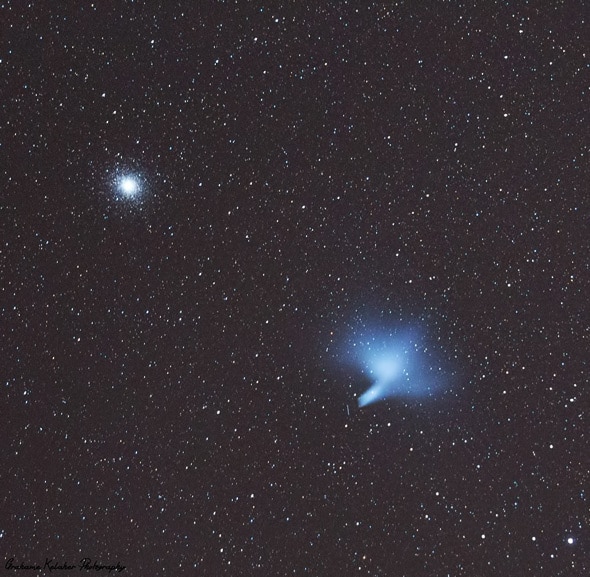Create a free profile to get unlimited access to exclusive videos, sweepstakes, and more!
Look! Up in the Sky! It’s a Bird, It’s a Plane … Actually, It’s a
Bird and a Rocket.

If you look up into the sky long enough, you’ll see the weirdest things.
Astrophotographer Grahame Kelaher was in Western Australia late at night on Feb. 6, and he saw the odd, fan-shaped blue glow in the photo above moving across the sky. He wasn’t surprised, though: He planned for it!
That’s not some nebula—it’s actually the glow from fuel dumped into space by the Centaur upper stage of a United Launch Alliance Atlas V rocket! The Atlas launched from Florida on Feb. 5,* carrying an Air Force Global Positioning System satellite GPS IIF into orbit.
The Atlas was configured for this launch as a two-stage vehicle. The lower, first stage, lobbed the upper stage, called a Centaur, and the GPS sat high above the Earth. The Centaur then burned to put itself into an elliptical “parking orbit,” then it burned again to achieve the desired near-circular orbit 20,450 kilometers from the Earth’s center (roughly 14,000 kilometers above the surface).
Once that happened, it performed three tasks: It released the satellite, it made a “collision avoidance maneuver” to make sure it wouldn’t accidentally hit the satellite, and then dumped the remaining fuel in its tanks into space for safety.
These events occurred when the Centaur was over Australia, and Kelaher captured them on video!
In the video you can see the plume of gas lit by the Sun (it was 03:00 local time, but the Centaur was high enough up to be in sunlight). Because it’s essentially a vacuum that high up, the gas cloud expands without friction and moves along with the Centaur and satellite. You can see (what I presume is) the GPS satellite moving along with the plume, just to the lower left.
Moving across the sky they appear to pass several well-known astronomical objects, including the fantastic globular cluster Omega Centauri and the spectacular Carina Nebula.
Because the launch time and orbit were known in advance, Kelaher could know in advance to see them … as he had been hoping and planning to for six years!
Patience pays off.
I’ve never seen anything like this, though I once saw a rocket booster burn up in re-entry many years ago, and it was amazing. This would really be something to observe! Rocket launches can create all kinds of truly spectacular and bizarre sights. And I’ll add that you can see many satellites with the naked eye (check Heavens Above for local listings of visible satellites), and it can be a real kick to spot one and identify it.
Going out under the night sky is never time wasted. The rewards are many, and if you do it enough, the bonuses can be pretty nice, too.
Tip o’ the payload fairing to the Ice in Space group on Facebook, and to Suzy Webb in particular.
* Correction, April 21, 2016: I originally misstated that the launch was on April 5.














